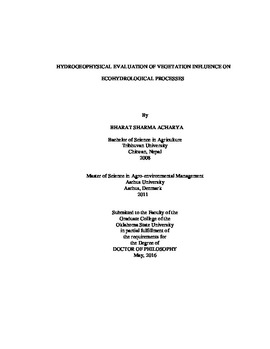| dc.contributor.advisor | Zou, Chris B. | |
| dc.contributor.author | Sharma Acharya, Bharat | |
| dc.date.accessioned | 2017-02-22T22:10:34Z | |
| dc.date.available | 2017-02-22T22:10:34Z | |
| dc.date.issued | 2016-05 | |
| dc.identifier.uri | https://hdl.handle.net/11244/48868 | |
| dc.description.abstract | Understanding the spatio-temporal heterogeneity of ecohydrological processes at the soil-plant interface and through the vadose zone is necessary to understand soil, vegetation and climate relations for land use and water resource management and planning in the south-central Great Plains, USA. We calibrated and validated a frequency domain dielectric sensor to quantify litter water content to estimate litter interception of precipitation in situ. Results from 6-months in situ measurement showed that the litter interception of a closed canopy redcedar woodland accounted for about 10% of gross rainfall, constituting a substantial component of the water budget in a sub-humid environment. Time-lapse electrical resistivity imaging was used to track deep moisture dynamics in a tallgrass prairie, prairie encroached by redcedar, closed-canopy redcedar woodland, and oak forest, and to evaluate subsurface flow in the tallgrass prairie with a thin soil over porous bedrock. Results indicated vegetation induced changes in the vertical soil moisture profile, increased spatial-temporal variability in root zone hydraulic conductivity under redcedar encroachment, two-layered moisture migration profiles, and subsurface lateral flow in the tallgrass prairie. Lateral flow was confirmed by short term temporal ERI that tracked movement of water from a berm infiltrometer. Water level from shallow monitoring wells showed higher water levels in the tallgrass prairie than in the redcedar woodland, which suggests that woody plants can decrease the water table in a perched aquifer by a significant amount. Mean soil chloride content varied between 5 to 162 mg L-1 in the tallgrass prairie and 88 to 612 mg L-1 in the prairie encroached by redcedar. Higher soil chloride concentrations under redcedar encroachment indicate reduced percolation and groundwater recharge potential associated with woody plant encroachment. The estimated deep drainage rate was 9.0 mm and 0.30 mm in the tallgrass prairie and redcedar woodland respectively. This study demonstrates that vegetation controls soil water dynamics, and hydrogeophysical methods have the potential to be used for broader understanding of ecology and hydrology in ecosystem studies. | |
| dc.format | application/pdf | |
| dc.language | en_US | |
| dc.rights | Copyright is held by the author who has granted the Oklahoma State University Library the non-exclusive right to share this material in its institutional repository. Contact Digital Library Services at lib-dls@okstate.edu or 405-744-9161 for the permission policy on the use, reproduction or distribution of this material. | |
| dc.title | Hydrogeophysical evaluation of vegetation influence on ecohydrological processes | |
| dc.contributor.committeeMember | Will, Rodney E. | |
| dc.contributor.committeeMember | Halihan, Todd | |
| dc.contributor.committeeMember | Fox, Garey | |
| osu.filename | SharmaAcharya_okstate_0664D_14644.pdf | |
| osu.accesstype | Open Access | |
| dc.type.genre | Dissertation | |
| dc.type.material | Text | |
| thesis.degree.discipline | Natural Resource Ecology and Management | |
| thesis.degree.grantor | Oklahoma State University | |
